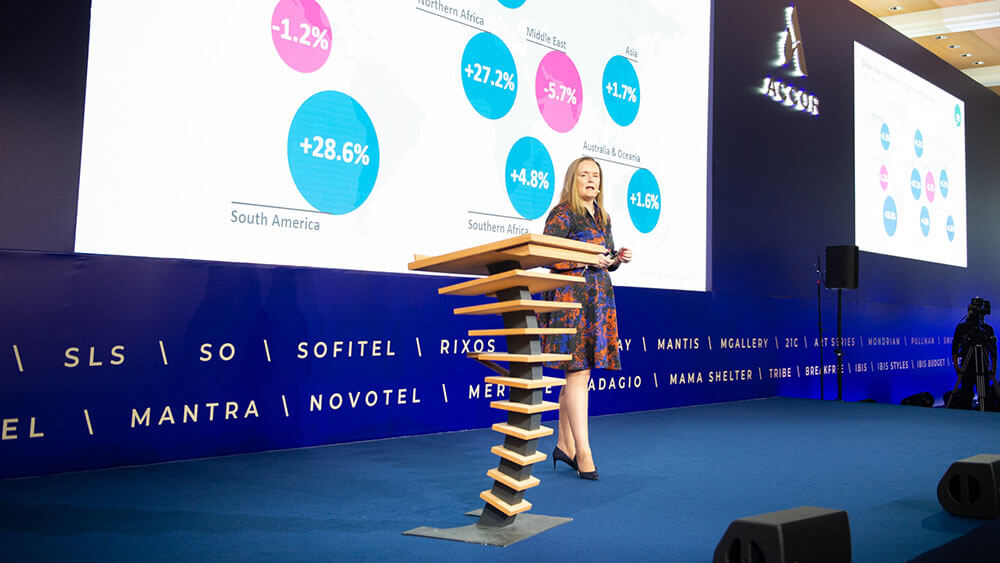
Sarah Duignan, director of international client relations for STR, speaks about hospitality trends at the Fairmont Le Montreux Palace in Montreux, Switzerland.
As director of international client relations for STR, a global data company that analyzes supply and demand in the hotel industry, Sarah Duignan has the inside track when it comes to knowing where the world’s hotel markets are heading. Duignan shared her insights with 280 participants — including 130 meeting planners and Convene — in a presentation, “Global Hospitality Trends — What Meeting Planners Should Know,” at the Global Meeting Exchange, held at the Fairmont Le Montreux Palace, March 27–29, in Montreux, Switzerland.
It’s all about the context. That was one of the underlying messages when Duignan reported on and interpreted the data at the event, hosted by Accor, the fifth-largest hotel chain in the world.
One example is the 5.2-percent boost for hotels in Europe in 2018, which looks even stronger, Duignan said, when you take into account that Europe also has experienced difficult contributing factors, “terrorism being one of them, of course.” In the same period, average RevPAR (revenue per available room) in North America grew by 3 percent, which, she added, “is nothing to sneeze at.” The equilibrium has changed when comparing North America to Europe, Duignan said. “What we were seeing two years ago is that North America would lead the way, and Europe would follow suit. That has shifted.”
In North Africa, where RevPAR grew at a galloping 27 percent, you might think that means that “wow, hotel rooms are super expensive,” Duignan said. The caveat: Two or three years ago, the average base rate for hotel rooms in some North African countries was $25, she said. And the 6-percent decrease in RevPAR in the Middle East isn’t a signal of dwindling demand, Duignan said. “This is entirely due to supply … supply, supply, supply, supply, supply.”
Overall, she said, the global trend for the world’s hotel market is one of “significant global demand growth,” except in Central America, where it slipped by 3.6 percent last year.
Here are highlights of what’s been happening in key regions around the world:
North America
It will come as no surprise to meeting planners that group RevPAR increased in 2018 in major U.S. cities, including San Francisco, Boston, New York City, and Chicago, which at 8 percent, had the largest gain. Washington, D.C., was an exception — in that city, RevPAR declined by 12 percent, which Duignan attributed to the U.S. government shutdown.
Although demand has been outpacing supply, the number of U. S. hotel projects in the pipeline, as reported in February 2019, would increase hotel room counts “by just shy of 12 percent,” Duignan said. “That represents — hold on to your seats — 658,000 more hotel rooms. That’s massive.” It is likely that not all of those rooms will come to fruition, she said, but 5.5 percent of them are projected to open in 2019, and those are “all but guaranteed.”
Asia Pacific
Supply has grown “a massive amount” in the Asia Pacific region, particularly in China, where some brands open hotels, “not by three or four a year, but by the hundreds,” Duignan said. Still, occupancy is above 70 percent in the region, she said, “an amazing feat.” The region leaders are Singapore, followed closely by Hong Kong, both destinations with “an absolutely booming market.” In Australia and New Zealand, where “very little supply” was being added for a very long time, “that is starting to shift,” she said. “We are starting to see the effects of new supply coming in.” If all the hotels in the pipeline actualize in Auckland, New Zealand, the city will add 45 percent more hotel rooms. In Sydney, Australia, that figure is 33 percent.
Middle East
In the United Arab Emirates, Dubai will host the global Expo 2020 next year, and supply is increasing so much that “it’s a bit of a race to the bottom in terms of rate,” she said. About 80,000 rooms are expected to open in Dubai in the next three to five years. Although the supply of new hotels is slowing, the region is still expecting increases in excess of 50 percent in some cities, including Dubai, which projects an overall 58-percent increase in hotel rooms, with 20 percent scheduled to open in 2019. Mecca, Saudi Arabia, soon will be home to a 10,000-plus-room hotel — the world’s largest — 4,500 of which will be ready for guests at the end of 2019, she said.
Europe
“For once, I can say that Ireland is No. 1 in something,” said Duignan, who is Irish. In 2018, Dublin led Europe with an 84-percent occupancy rate, followed closely by London, at 83 percent, she said. The high occupancy rate in Dublin can be traced to the fact that limited supply has been added in recent years, she said. The U.K. leads in the number of hotel rooms coming on the market, with nearly 150,000 rooms reportedly in the pipeline, a 15-percent increase. In London, the number of hotel rooms is projected to increase by more than 4 percent in 2019. Germany has 100,000 rooms in the pipeline, including a 5-percent increase in the number of hotel rooms in Frankfurt in 2019. In Eastern Europe, Poland is a growing market, with a 27-percent increase of hotel rooms in the pipeline — Warsaw is expected to see a 4-percent increase in hotel rooms this year.
